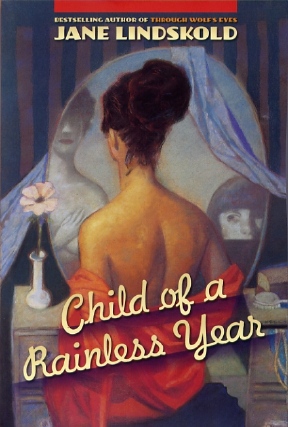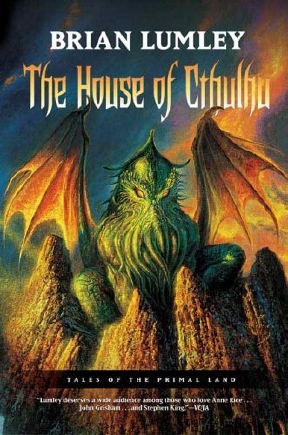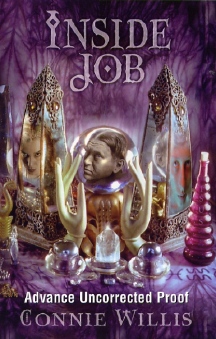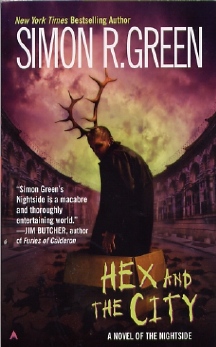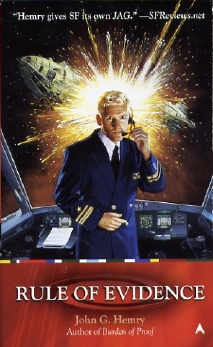|
|
|
This Just In...News from the Agony Column
|
05-13-05: Jane Lindskold Child of a Rainless Year |
|||
Waking
Up the House
'Child of a Rainless Year' begins as Mira Fenn remembers her mother -- her real mother, who told her child that she was born in a year when there was no rain. Her real mother, Collette, lived in Las Vegas, New Mexico, tended by oddly silent servant women, and took frequent unexplained trips, one of which she never returned from. Mira was placed with foster parents in a normal home in Ohio. She lived a normal life until her foster parents died. Now, middle-aged Mira finds that she still owns the New Mexico house. When she returns, it's not to the same house she left. Outside, it's been painted innumerable colors, reflecting Mira's own interest in colors. Inside, its the same. But when Mira returns, so do the silent women. And the house itself appears to be waking up. So it's clear what we have here is a fantasy veteran taking a shot at mainstream American magic realism, and I'll be damned if it doesn't look like she's done a pretty good job of it. Lindskold is smart enough to know how and when to draw elements of the fantastic into her world of domestic bliss. Oddly enough, I'd suggest that this might even share a few elements in terms of tone and content with the most recent Cory Doctorow novel, 'Someone Comes to Town, Someone Leaves Town'. We have the beginnings of our own new little sub-genre here. Call it what -- Domestic Fantasy, Suburban fantasy? There are more and more novels that have the potential to break right out into the mainstream, a la 'The Lovely Bones', wherein normal folks find themselves in the midst of the not-so-normal goings on, usually because some family member is actually dead, a ghost, an elf, a witch, and in Doctorow's case, a washing machine. Even the cover art tells us that this is a different beast than Lindskold's 'Firekeeper' novels. Gary Kelley's evocative image suggests the strange, but does not shove it down our throat. And there's nary a bit of Land's End apparel to offend the eye. I wouldnt be surprised, however, to find some talking animals in the narrative. We all need our totem, our power animal to connect us to the spiritual world. Just hope that yours isnt, for example, the spider -- or the fly. |
|
05-12-05: Brian Lumley enters 'The House of Cthulhu' |
|||
Wearing
the Weird Horror Fantasy Hat
Here in the shiny 21st century, we have a Republican president and thus, the horror business is booming. So Tor has seen fit to root about in the publishing equivalent of a Native American graveyard, that is, Lumley's extensive back-catalogue, to bring forth nice, shiny (of course!) hardcover editions of his work that hasnt ever really seen the light of day in your local chain bookstore or even, in many cases, your local independent bookstore, unless theyre a genre specialist. Thus, we're getting the gorgeously designed Tor hardcover version of Lumley's 'The House of Cthulhu' (September 1, 2005) just in time for your Labor Day cookout. Chances are you won't be putting any calamari on the menu if youre a Lumley fan. That wonderful, worth-the-cover-price Bob Eggleton painting of our favorite sleeping-dreaming undersea god is enough to send shivers -- of delight -- down your spine. And Lumley himself will follow through. So, yes, he wears many hats. Sometimes, he writes gory contemporary horror in his 'Necroscope' series. Sometimes, he writes high fantasy in that same series. 'The House of Cthulhu' offers a series of connected stories that combine the two modes, in the manner of author Clark Ashton Smith. Lumley does a pretty damn good job with a lapidary prose style and a page-turning plot, then throws in some awe-inspiring gore just to make things red and splattery. There are echoes of Robert E. Howard's best work in the Conan series here, and of course, H. P. Lovecraft as well. But though Lumley is working in another man's mythos, he makes it his own with his peculiar voice -- that voice of your unsavory British uncle, who whispers really bad things to you when your parents aren't looking. It's impossible to read Lumley without hearing the sound of the storyteller's voice. It adds up to a lot of style that is decidedly and pleasantly out-of-step with today's transparent prose brigade. With Eggleton's wonderful cover, there's a chance that this novel will make it in two genres -- horror and fantasy, which is rather appropriate, since it is both horror and fantasy. Better yet -- though not surprising -- there's a lot more where this came from. So if you've not yet managed to get a shelf full of Ganley editions, Tor will happily accommodate you with these lovely Eggleton-covered versions. And even if you do have the Ganley's, the updated packaging looks very nice. Better build another room for your books in the basement. I'm here to tell you we're only partway through Lumley's headgear collection. |
|
05-11-05: Connie Willis Does an 'Inside Job' |
|||
A
New Novella from Subterranean Press
The story is an old and familiar one, but its the kind of plot skeleton with which a writer like Willis can work wonders. Rob and Kildy are spiritual debunkers. They're the ones that save us from being bilked by "psychic cosmetic surgeons", assuming, of course, that this is a danger to you. I have to admit that psychic liposuction seems extremely unwise, but then, after seeing an episode of "Freddy Krueger's Nightmares" (at least I think that's what the deservedly short-lived series was called) liposuction itself seems pretty nightmarish. Don't worry, I didn't lose the plot in the tides of fatty effluence. The plot here has Rob and Kildy, the two debunkers, headed out to see a spectacular new psychic. Is this the real deal? Willis takes reader on the journey to find out in a mere 99 pages. Willis has a strong sense of humor and it's deployed with a generous hand here. I dont know about you, but I've got to love a novella about debunking that begins with the H. L. Mencken quote, "Nobody ever went broke underestimating the intelligence of the American people." Some things get truer every day, and that is certainly one of them. It will probably end up as the epitaph for both the 20th and the 21st centuries. But it gets better and better; not only does Mencken get quoted throughout the novella, he makes an appearance from his current residence in the spirit world. Or (of course!) does he? What better spirit to channel than that of the world's most -often quoted skeptic. Of course, any novel(la) that sports a cover with Mencken's head in a jar, Disneyland Haunted-House style should of course say "Buy Me!" to even the most skeptical reader. Willis does a whole lot of Southern California name-dropping here, with loads of very funny movie references (are you looking forward to The Hulk III?) and publishing in-jokes. This novella is brand-spankin' new and one suspects the kind of thing that gets a Stoker nomination as well as a serious uptick in value once it goes out of print. It also has some serious attraction to our Fortean readers, those of us who can't get enough spirits and scams. Given how popular Willis is, I would suggest it to be a wise idea to order in advance. Otherwise you might find yourself needing a psychic just to read it. |
|
05-10-05: William F. Nolan Explores A 'Wild Galaxy' |
|||
Classics
from a Class Act
But Nolan is more than a science fiction writer. He was part of a famous group of writers who hailed from Southern California, and included Richard Matheson, Ray Bradbury, Charles Beaumont and George Clayton-Johnson. It's impossible to estimate the impact this group of men had on American culture. Between their well-known novels and collections, and their contributions to television via 'The Twilight Zone', they shaped popular weird fiction and the popular perception of weird fiction for many years, and it is certain that we'll never escape their influence. Bradbury is an acknowledged literary giant who is still writing new work, as are Richard Matheson and George Clayton-Johnson. Beaumont alas, died in 1967. You'd think that a group of writers like this would be perennially in print, and youd be right, but it's not the New York publishers who do so, unless they deign to bring out a movie tie-in. The first William F. Nolan book I bought was 'Things Beyond Midnight', a 1984 Scream/Press collection of his best horror stories. Ah, the wonderful days of the 1980's small press. There were so many great collections by so many great publishers, now, sadly most of them defunct. I've rhapsodized about Scream/Press before. Another now-gone publisher, Dark Harvest, brought us a wonderful collection by Charles Beaumont, featuring scary clown cover art by Peter Scanlan that will curl your toes. And once again, the small press is bringing readers the work of William F. Nolan. This time, Golden Gryphon has lined up a selection from more than fifty years of stories by this talented writer in 'Wild Galaxy' (Golden Gryphon ; May 1, 2005 ; $23.95). While 'Logan's Run' once again gets a turn at the movies, Marty Halpern and Gary Turner have collected stories that cover the whole range of SF; some satiric, some serious and some seriously silly. What readers can discover here are the origins of popular science fiction, the templates from which TV and movies learned (often not too well) about science fiction. Having the originals to hand will give you an insight on where the field has come from -- and offer entertainment of a different order. Since this is Golden Gryphon, they've sweetened the deal with a perfectly classic cover by Bob Eggleton, with a retro spaceship you might have found on the twirling racks at Zody's back in Covina. Of course, this being the kind of quality hardcover that we can count on from Golden Gryphon, it wont be rotting away some thirty years from now. No, you can count on the folks from Hollowood -- they'll still be consulting on Nolan and his work. They'll discover it in the small press, adapt it, and then spit out mass-market paperbacks that will be rotting thirty after that. As another generation discovers Nolan's work in small press editions. |
|
05-09-05: John G. Hemry 'Rules of Evidence': Space-Based Military Mystery; Simon R. Green 'Hex and the City': Back on the Nightside With John Taylor |
||||||
Ace Paperbacks You Should Buy and Why
To my mind, a much better way is probably Simon R. Green's 'Nightside' series. And as much as I like mass-market paperbacks, I can't help but hope that someday, some enterprising small press will reprint them in quality hardcovers illustrated by someone like J. K. Potter, or John Picacio, or Les Edwards. Hey, I can dream, can't I? But of Simon R. Green 'Nightside' books, I need not dream. I merely need to go to the bookstores and pick up his latest, 'Hex and the City' (Ace Fantasy / Penguin Putnam ; February 22, 2005 ; $6.50). Green's little novels about a detective in a supernatural suburb of London -- 'Something from the Nightside', 'Agents of Light and Darkness' and 'Nightingale's Lament' -- are just the thing to take the edge off; they're funny, very fast, quite well-written, yet determined to be utterly lightweight. Of course, that doesn't stop Green from getting in some rather heavy-duty subjects, in this case, the origins of the Nightside and his own mother. It seems that lady Luck has hired John to find out about the origins of their mutual home, and in return she promises to tell him something about his mother. Sure, we know that there's not going to be a lot of good news here. But we also know that Green will offer us 246 pages of blissfully fast reading, great monsters and witty repartee. I've been a fan of this series since its inception, and I make a point of reading every one. Mostly because it's so damn fun.
Now, there is one problem with the books -- not only the latest, but the first two -- and it is a problem that is all-too-common these days. If you pick up this book -- or either of the other two -- do not read the back cover blurb, which gives away far too much of the plot. Just know that going in, this time around, Paul Sinclair, the legal officer aboard the USS Michaelson, is going to be presented with a problem that will be rather close to him. It seems that the South Asian Alliance wants more space, but given the size of the solar system, there should be enough to go around. The threat of the SASAL is enough to get the US and the Euros to run maneuvers together. Hemry deftly puts together a situation that has lots of echoes in today's world in a near future that is reasonably realistic, then marches characters we care about into situations we'd really rather not see them enter -- but for the fact that it makes good reading. Funny how that is -- that to enjoy reading, we readers both have to like the characters and see them put in harm's way. Yes, and we may snatch them out of harm's way ourselves. Do yourself a favor. Go save a paperback from the heinous fate that awaits it. Buy both of these books. Read them, enjoy them, donate the copies to your local high school. You'll need room on your shelves for when Night Shade puts out the hardcover illustrated editions, and the person in your life who tells you that there's only so much space in your living quarters will be pleased. Maybe they won't notice the big stack of books left behind, well for a couple of days at least. And you can show them that though they stay on my rolling shelves, you were good enough to read them and then donate them. What more can they ask of us? |
